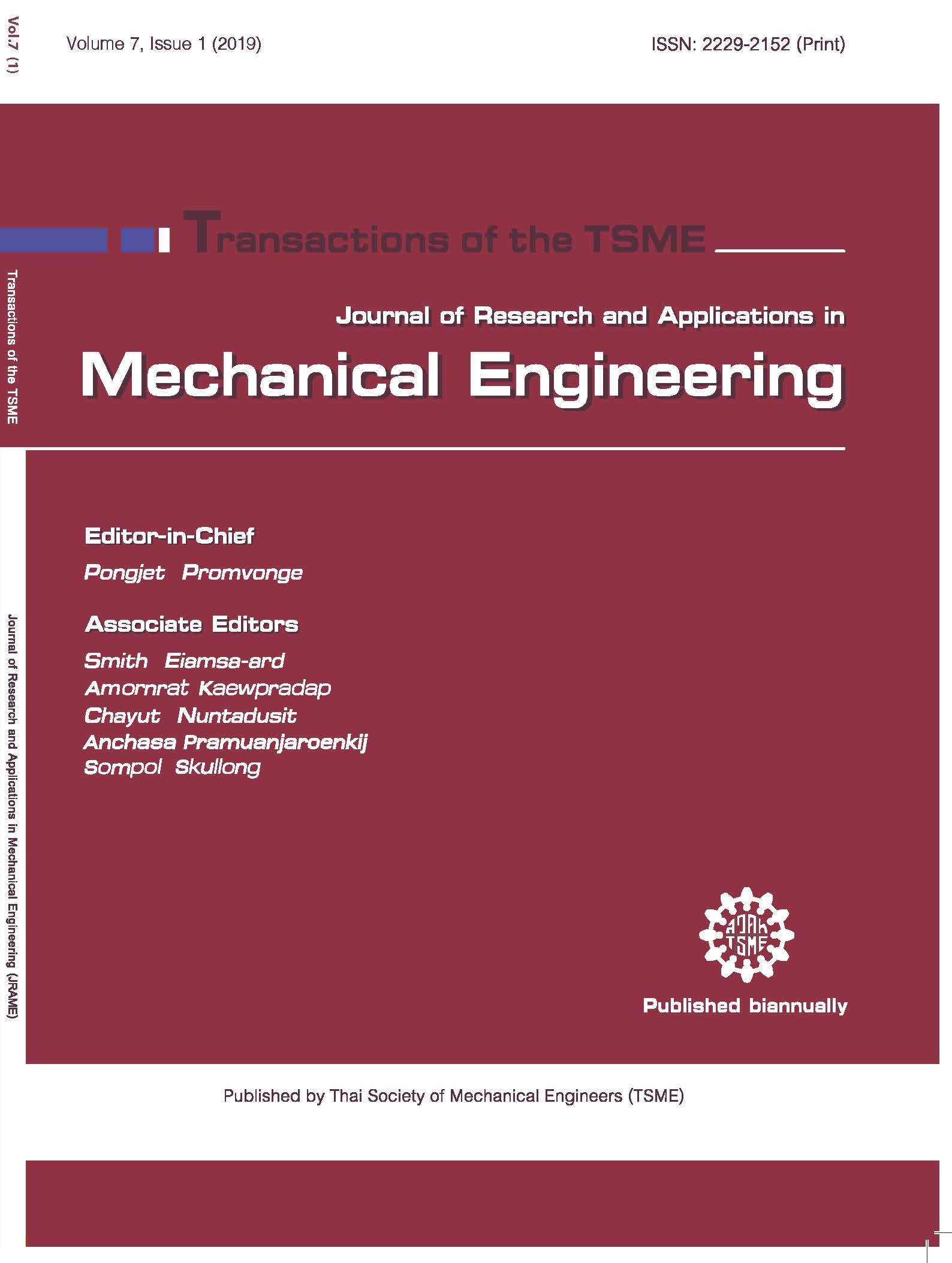Numerical study of resistance and form factor of high-speed catamarans
Main Article Content
Abstract
Since the prediction of resistance of the full-scale ship mainly relies on extrapolation of form factor of the model, it is important to determine the form factor precisely. Nowadays, the computer performance has been developed, commercial CFD code with Reynolds-averaged Navier-Stokes Equations (RANS), which is widely accepted and used by many researchers is capable of determining resistance components. This paper presents the development and procedures for the prediction resistance components and form factor of displacement catamarans by using commercial CFD code, STAR CCM+, with SST k-ω turbulence model. The Wigley catamarans with three hull configurations including S/L = 0.2, 0.3 and 0.4 are investigated at Froude number between 0.2 and 0.8. Resistance components, which are total (CT), skin friction (CF), viscous (CV), residual (CR) and wave (CW) resistance, form factor (1+k), form resistance interference factor (β), wave resistance interference factor (τ) and wave elevation along the hull are estimated and validated against experiment retrieved from Insel (1992). The results show that CFD code with RANS equations is capable of estimating resistance components and demonstrates that form factor increases with speed (Fn).
Article Details
This work is licensed under a Creative Commons Attribution-NonCommercial-ShareAlike 4.0 International License.
References
[2] Molland, A.F., Wellicome, J.F. and Couser, P.R. Resistance experiment on a systematic series of high speed displacement catamaran forms: Varian of length-displacement ratio and breadth-draught ratio, Ship Science Report 71, Southampton: University of Southampton, 1996.
[3] Utama, I.K.A.P. Investigation of the viscous resistance components of catamaran forms, PhD Thesis, 1999, University of Southampton, Southampton.
[4] Morarez, H., Vasconcellos, J. and Latorre, R. Wave resistance for high-speed catamarans, Ocean Engineering, Vol. 31(17), 2014, pp. 2253-2282.
[5] Pranzitelli, A., Nicola, C. and Miranda, S. Steady-state calculations of free surface flow around ship hulls and resistance predictions, paper presented in High Speed Marine Vehicles (IX HSMV), 2011, Naples, Italy.
[6] Wackers, J., Koren, B., Raven, H.C., van der Ploeg, A., Starke, A.R., Deng, G.B. et al. Free-surface viscous flow solution methods for ship hydrodynamics, Archives of Computational Methods in Engineering, Vol. 18(1), 2011, pp. 1-41.
[7] Larsson, L., Stern, F. and Visonneau, M. Gothenburg 2010, A workshop on numerical ship hydrodynamics. Gothenburg, Sweden, 2010.
[8] Aktar, S., Saha, G.K. and Alim, M.A. Drag analysis of different ship models using computational fluid dynamics tools. paper presented in the 6th International Conference on Marine Technology MARTEC 2010, Dhaka, Bangladesh.
[9] Zha, R., Ye, H., Shen, Z. and Wan, D. Numerical computations of resistance of high-speed catamaran in calm water, Journal of Hydrodynamics, Ser. B, Vol.26(6), 2014, pp. 930-938.
[10] Samuel, S.I.M. and Utama, I.K.A.P. An investigation into the resistance components of converting a traditional monohull fishing vessel into catamaran form, International Journal of Technology, Vol. 6(3), 2015, pp. 432-441.
[11] Froude, W. Experiments on the surface-friction experienced by a plane moving through water, Report of British Association for the Advancement of Science, 1872.
[12] Hughes, G. Friction and form resistance in turbulence flow and a proposed formulation for use in model and ship correlation, Transaction of the Royal Institute of Naval Architects, Vol. 96, 1954, pp. 314-376.
[13] Kasahara, M. and Masuda, S. Verification of simulation flow field around ships by using CFD Code, Paper presented at the Proceedings of the Third Osaka Colloquium Advanced CFD Applications to Ship Flow and Hull Form Design, 1998, Osaka, Japan.
[14] Larsson, L., Stern, F. and Bertram, V. Gothenburg 2000, A workshop on numerical ship hydrodynamics, Gothenburg, Sweden, 2002.
[15] Hino, T. CFD workshop Tokyo 2005, National Maritime Research Institute, Japan, 2005.
[16] ITTC. Report of the Resistance Committee, Proceedings of the 23rd International Towing Tank Conference, 2002, Venice, Italy.
[17] Srinakaew, S., Taunton, D.J. and Hudson, D.A. A study of resistance of high-speed catamarans and scale effects on form factor, paper presented in proceeding of the 19th Numerical Towing Tank Symposium (NUTTS’16), 2016, St Pierre d’Oleron, France.



